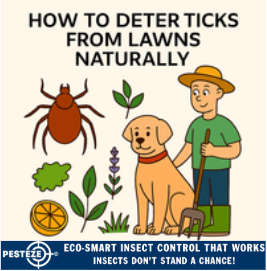HOW TO DETER TICKS FROM LAWNS NATURALLY

HOW TO DETER TICKS FROM LAWNS NATURALLY
SUMMARY
Ticks in lawns pose serious health risks, including Lyme disease and other tick-borne illnesses. These pests thrive in tall grass, leaf litter, and shaded areas. By maintaining your lawn, using natural repellents, and implementing preventive landscaping strategies, you can reduce tick populations and make your outdoor spaces safer for family and pets.
FEATURES
-
Keep Grass Short – Regular mowing eliminates tick habitats in tall grass.
-
Remove Leaf Litter and Debris – Clear fallen leaves, brush, and wood piles where ticks hide.
-
Use Natural Repellents – Essential oils like cedarwood, eucalyptus, and neem deter ticks.
-
Create Tick-Safe Zones – Gravel, wood chips, or mulch barriers reduce tick movement near play areas.
-
Maintain Wildlife Control – Discourage deer, rodents, and other animals that carry ticks.
-
Treat Pets with Flea and Tick Prevention – Reduce tick introduction by regularly treating outdoor pets.
GUIDE DESCRIPTION
Ticks are a hidden threat in lawns, gardens, and shaded outdoor spaces. They attach to humans and pets, potentially transmitting dangerous diseases. Reducing tick populations requires proactive lawn care, natural deterrents, and wildlife management.
The first step is keeping grass short. Ticks prefer tall, humid grass for shelter, so mowing regularly makes your lawn less hospitable. Edge trimming along fences, gardens, and pathways also reduces tick habitats.
Removing leaf litter, brush, and debris is equally important. Piles of leaves, fallen branches, and unkempt wood or compost piles provide shelter for ticks and their hosts. Clearing these areas limits tick populations and reduces the chance of them spreading into active spaces.
Natural repellents can enhance lawn protection. Essential oils such as cedarwood, eucalyptus, and neem can be diluted with water and sprayed along pathways, around the yard perimeter, or near shrubs. These scents deter ticks while being safe for children and pets.
Creating tick-safe zones around patios, playgrounds, and frequently used areas helps reduce exposure. Using gravel, wood chips, or mulch as barriers discourages ticks from crossing into active spaces. Maintaining a clear border between wooded or grassy areas and your lawn can also limit tick migration.
Controlling wildlife is another preventive strategy. Deer, rodents, and other small animals often carry ticks into your yard. Installing fencing, removing bird feeders close to play areas, and discouraging rodent activity reduces the introduction of ticks.
Finally, ensure that pets receive regular flea and tick treatments. Outdoor pets can carry ticks from infested areas to your lawn or home. Vet-approved topical treatments, collars, or oral medications help protect your pets and reduce the spread of ticks.
By combining lawn maintenance, debris management, natural repellents, tick-safe zones, wildlife control, and pet treatments, you can effectively deter ticks from lawns. These strategies create safer outdoor spaces for your family and pets, minimizing the risk of tick-borne illnesses.
- Shashank Rongali


Comments 0